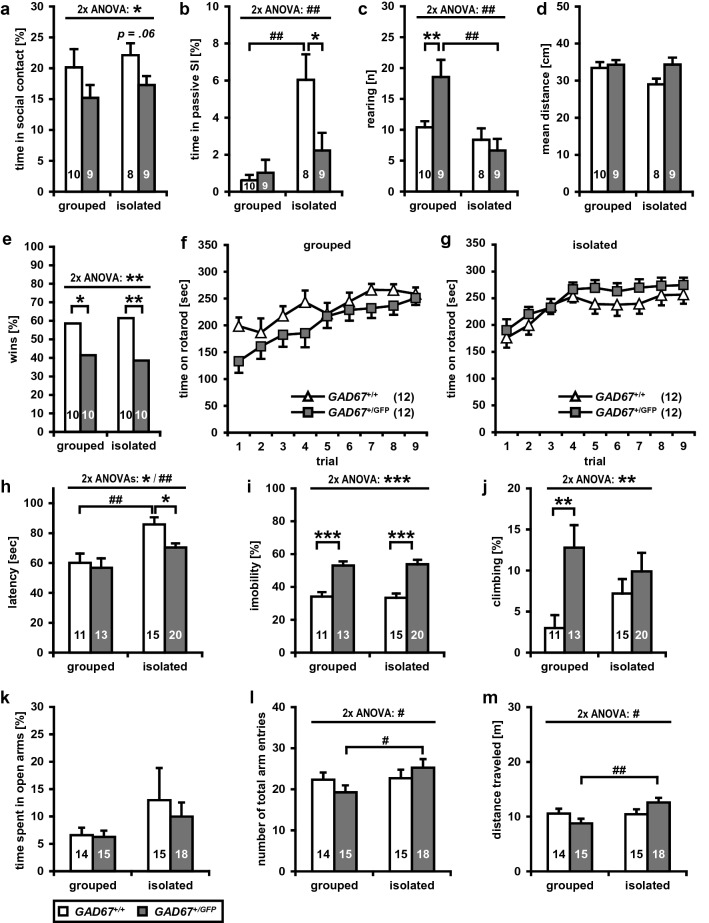Fig. 1.
GAD67+/GFP mice exhibit a subset of negative symptom-like behavioral deficits. a–d In the social interaction test a genotype had a significant main effect on time spent in social contact. However, only isolated GAD67+/GFP mice, compared to isolated GAD67+/+, showed a trend towards a lower time spent in social contact. b Social isolation had an effect on passive social interaction. Socially isolated GAD67+/+ mice spent significantly more time in passive social interaction than group-housed GAD67+/+ mice. Isolated GAD67+/GFP showed a significantly lower passive social interaction than socially isolated GAD67+/+ mice. c Social isolation had a significant effect on rearing activity. Isolated GAD67+/GFP mice revealed a lower rearing activity than group-housed GAD67+/GFP. Group-housed GAD67+/GFP showed a significantly higher rearing activity compared with group-housed GAD67+/+. d There were no differences in locomotor activity. e In social dominance tube test isolated and grouped GAD67+/GFP lost significantly more bouts, than GAD67+/+ mice. f, g Genotype and housing showed no effect on rotarod performance. h–j In the forced swim test significant main effects for genotype and housing were found for latency to appearance of first immobility period. h Isolated GAD67+/GFP, compared to isolated GAD67+/+ mice showed a significantly reduced latency. Interestingly, social isolation increased the latency of GAD67+/+ mice. iGAD67+/GFP exhibit a significantly increased time spent in immobility, independent from housing condition. j The genotype showed an effect on climbing activity. Group-housed GAD67+/GFP mice revealed a significantly higher climbing activity, compared to GAD67+/+. k–m In the elevated plus maze test, no differences were found for k time spent in open arms. l The number of total arm entries was dependent on the housing condition. Social isolation significantly increased the number of total arms entries, of GAD67+/GFP mice. m Social isolation had an effect on locomotor activity on EPM. Social isolation significantly increased the distance traveled in GAD67+/GFP mice. Statistics: Animal number n is indicated in parentheses or plot bars. Data are presented as mean ± SEM. The social interaction test, forced swim test, elevated plus maze rotarod were analyzed using two-way multivariate analyses of variance (MANOVA) or repeated measures ANOVA with GENOTYPE (two levels: GAD67+/+ and GAD67+/GFP) and HOUSING (two levels: group housed and isolated) as between-subject factors. Post hoc analyses were performed using unpaired t tests. The social dominance tube test was analyzed using a binary logistic model followed by Wald Chi-square test. *p < 0.05, **p < 0.01, ***p < 0.001 vs. GAD67+/+ mice. #p < 0.05, ##p < 0.01 vs. group-housed mice

